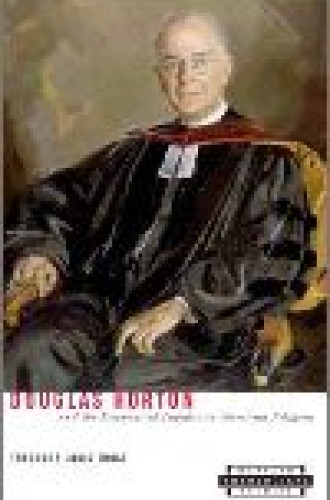Douglas Horton and the Ecumencial Impulse in American Religion
Now, when the ecumenical movement seems to be at low tide, there appears a scintillating biography of one of the premier 20th-century American ecumenists. In both status and leadership gifts Douglas Horton (1891-1968) was a prince of ecumenism. His passion and influence touched most of the expressions of “the ecumenical impulse,” which his biographer defines as “the historical movement toward catholicity and unity.” Horton’s ecumenical career, spanning more than 50 years, was multifaceted: he was a pastor, scholar, ecumenist, author, denominational head, international statesman and academic dean.
Born in Brooklyn, New York, to Congregational parents, he was mentored by S. Parkes Cadman, nationally known minister of the Brooklyn Congregational Church, president of the Federal Council of Churches, and American leader in early 20th-century ecumenical developments such as the Life and Work and the Faith and Order movements. Horton graduated from Princeton College (later University) during Woodrow Wilson’s presidency. He then prepared for congregational ministry at Hartford Seminary Foundation, where his ecumenical and missionary consciousness was nurtured by President W. Douglas MacKenzie, a leader of the historic World Missionary Conference at Edinburgh in 1910.
After his ordination Horton served Congregational churches in Middletown, Connecticut, and Brookline, Massachusetts, then the United Church of Hyde Park, a united Congregational and Presbyterian church in Chicago. While at Hyde Park in the mid-1930s he participated in a local ecumenical group of Congregational and Episcopal pastors and professors in Chicago. In 1938 they published The Basic Formula for Church Union, a blueprint for uniting churches with different confessions, polities and forms of worship.
A pivotal year in Horton’s ministry was 1938, when his reputation as a scholar and translator was enhanced by his translation of Karl Barth’s The Word of God and the Word of Man. It made Barth’s challenge to liberal theology accessible to English-speaking people and gave credibility to neo-orthodox theology in America. In the same year Horton was elected minister and secretary (chief denominational executive) of the General Council of the Congregational Christian Churches.
Early in his tenure conversations began toward organic union, unfortunately called “merger” in many circles, between the Congregational Christian Churches and the Evangelical and Reformed Church. Because of his denominational office and his determined advocacy of nothing less than full organic union, Horton was attacked by dissident Congregational groups who saw church union as obstructing the “freedom of autonomous congregations” as well as the principles and polity of historic Congregationalism. Some “political maneuvering and manipulating” on the part of Horton and others was involved in eventually achieving the formation of the United Church of Christ.
In the mid-1950s Horton’s ecumenical leadership drew him fully into international ecumenism. He was a delegate to the first (Amsterdam, 1948) and second (Evanston, 1954) assemblies of the World Council of Churches. He served the Faith and Order Commission as vice-moderator from 1954 to 1957 and moderator from 1957 to 1961. Twice in this period Horton made articulate defenses opposing attempts to alter Faith and Order’s central place within the World Council of Churches. He argued that unity—as understood by Faith and Order—is not only a matter of study but also a calling to decision, leading to one communion of faith and mission. He did not want to see Faith and Order “submerged in a vast structure devoted only to cooperation.”
In 1960 Horton critiqued those leaders in the member churches and the WCC who were wavering over whether the WCC’s central task is primarily to nurture cooperation among the churches or to lead them toward visible unity expressed in “one baptism, one gospel, the breaking of one bread, a corporate life of witness and service, a ministry and membership acknowledged by all, and the ability to act and speak together as occasion may require.” The gospel requires, he exclaimed, decidedly more than cooperation or dialogue among divided churches; full church unity is what God wants.
In 1955 Harvard President Nathan Pusey convinced Horton to become the dean of Harvard Divinity School. The vision and leadership of the new dean rejuvenated the divinity school and led it to become a distinguished ecumenical center. A first move was the establishment of the Stillman Chair of Catholic Theological Studies, against the protests of Paul Tillich and others. Other ecumenical lecturers soon invited to Harvard included Bonhoeffer interpreter Eberhard Bethge and Russian Orthodox theologian and ecumenist Georges Florovsky. In due time the Center for the Study of Religions became a part of the Divinity School.
Horton’s final ecumenical sojourn may have been his most influential. When in 1959 Pope John XXIII announced plans for the Second Vatican Council, observers from various Protestant and Orthodox churches were invited to attend. Horton, representing the International Congregational Council, was a major player among these observers. Horton’s legacy to the Protestant-Catholic dialogue includes his four-volume work Vatican Diary (1962-1965), which brought the official and unofficial happenings of Vatican II to pastors and laypeople—Protestant and Roman Catholic.
Theodore Trost, professor of religious studies at the University of Alabama in Tuscaloosa, has transformed his Harvard Ph.D. dissertation into a living saga of a critical period of modern ecumenical history. Ecumenical veterans and neophytes alike will find this book an essential read on the trials and joys of the modern ecumenical movement. Horton’s life illustrates that the journey toward the reconciliation and common mission of the people of God is only for the stout of heart and those who believe that unity is an undeniable gift of God. Such a vocation was possible for Horton because, as Trost says, “ecumenism remained for him the key to bringing into being the eschatological kingdom of God.”






